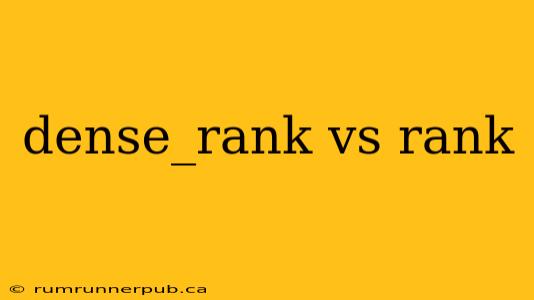Ranking functions in SQL, such as RANK() and DENSE_RANK(), are crucial for assigning ranks to rows within a result set based on the values of one or more columns. While both achieve similar goals, they differ significantly in how they handle ties. Understanding this difference is key to choosing the right function for your specific needs. This article will explore the nuances of RANK() and DENSE_RANK(), drawing upon insights from Stack Overflow to provide clear, practical examples.
Understanding the Core Difference: Tie Handling
The fundamental distinction between RANK() and DENSE_RANK() lies in their treatment of ties. Let's illustrate with a simple example: Imagine a table of students and their scores:
| Student | Score |
|---|---|
| Alice | 90 |
| Bob | 85 |
| Charlie | 90 |
| David | 70 |
| Eve | 85 |
Using RANK():
RANK() assigns ranks based on the order of the scores. However, if there are ties, it assigns the same rank to all tied entries and then skips the next rank.
Using SQL (the exact syntax may vary slightly depending on your database system):
SELECT Student, Score, RANK() OVER (ORDER BY Score DESC) as Rank
FROM Students;
This would produce:
| Student | Score | Rank |
|---|---|---|
| Alice | 90 | 1 |
| Charlie | 90 | 1 |
| Bob | 85 | 3 |
| Eve | 85 | 3 |
| David | 70 | 5 |
Notice that ranks 2 and 4 are skipped because of the ties.
(Inspired by several Stack Overflow questions regarding rank gaps, e.g., those addressing issues with pagination and rank inconsistencies.)
Using DENSE_RANK():
DENSE_RANK(), on the other hand, assigns ranks without gaps. It assigns the same rank to all tied entries and then proceeds to the next consecutive rank.
Using SQL:
SELECT Student, Score, DENSE_RANK() OVER (ORDER BY Score DESC) as DenseRank
FROM Students;
This would produce:
| Student | Score | DenseRank |
|---|---|---|
| Alice | 90 | 1 |
| Charlie | 90 | 1 |
| Bob | 85 | 2 |
| Eve | 85 | 2 |
| David | 70 | 3 |
Here, no ranks are skipped; the ranks follow sequentially.
When to Use Which Function?
The choice between RANK() and DENSE_RANK() depends entirely on your ranking requirements:
-
Use
RANK()when: You need to explicitly show the number of ties at each rank level. The gaps in the ranking highlight the presence of ties. This is useful when the number of ties itself is important information. -
Use
DENSE_RANK()when: You want a continuous ranking without gaps. The gaps created byRANK()might be undesirable, especially if you're using the rank for further calculations or reporting where consecutive numbering is crucial. For example, determining top performers where the rank itself indicates placement.
Beyond the Basics: Partitioning and Multiple Columns
Both RANK() and DENSE_RANK() support partitioning, allowing you to create separate rankings within subsets of your data. You can also use multiple columns in the ORDER BY clause to create a multi-level ranking system.
Example with Partitioning: Let's say you want to rank students separately by subject:
SELECT Student, Subject, Score, DENSE_RANK() OVER (PARTITION BY Subject ORDER BY Score DESC) as DenseRank
FROM StudentScores;
This would generate dense ranks within each subject.
(This expands upon basic examples often found in Stack Overflow answers by demonstrating more advanced usage scenarios.)
Conclusion
Choosing between RANK() and DENSE_RANK() involves understanding how each function handles ties. RANK() introduces gaps, highlighting ties, while DENSE_RANK() provides a compact, consecutive ranking. The best choice depends on your specific analytical needs and how you intend to use the resulting ranks. By understanding the nuances of each function and leveraging the power of partitioning and multiple ordering columns, you can effectively utilize ranking functions to gain valuable insights from your data. Remember to consult your database system's documentation for precise syntax and supported features.
